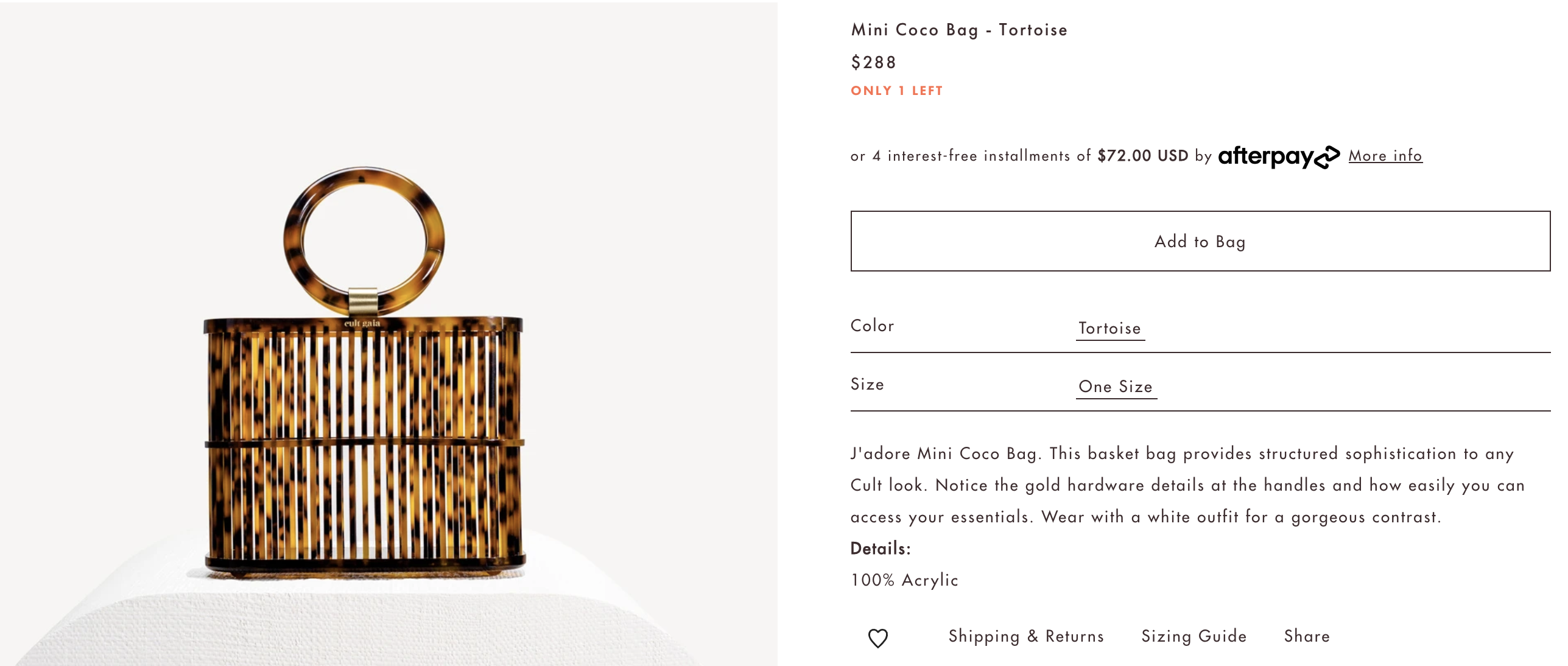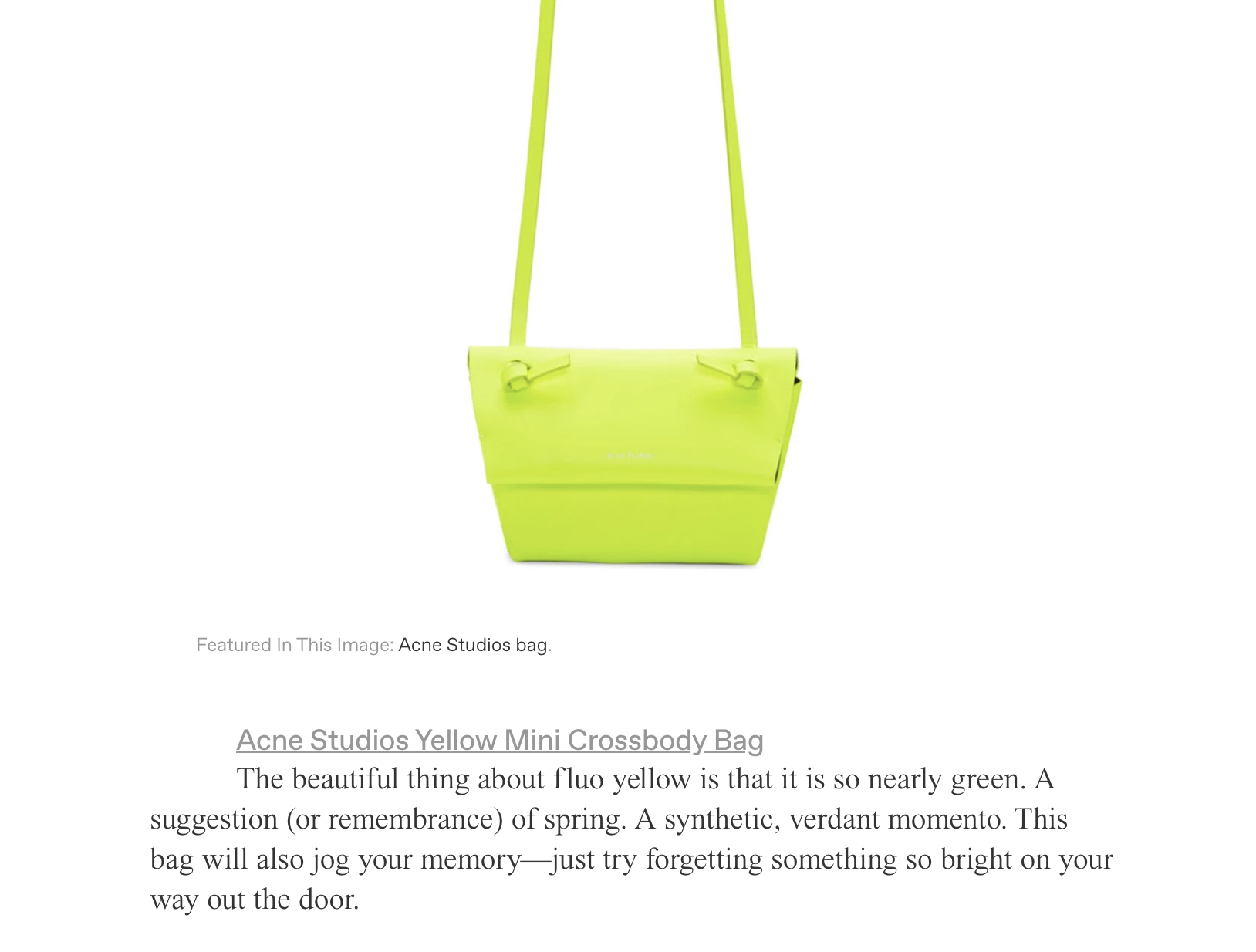A footwear designer once told me that when he sees someone wearing something he worked on, the pride he feels has to do with connection. Someone liked what he created enough to put it in their cart and onto their body, and now they walk around in it feeling (hopefully) cute. When liking something is as easy as clicking a button, this version of “like” feels strangely intimate. Also logistically complex, when you factor in the path the shoes took to go from inside his mind to laced onto a stranger’s feet.
I’m always confused when people talk about fashion as frivolous, because shopping is just another word for making choices. And what choices are available to you, and which of them you select, is entangled with everything from politics and economics to pop culture, race, beauty standards … Fashion touches on both the superficial and the incredibly deep.
Writing product copy for footwear and apparel sites, I see all this get distilled down to buzzwords and flat descriptions of target demographics. Brands tend to either inflate what they do or minimize it. It’s either “We're changing the planet one tee at a time” or “We're not doing heart surgery here.” Many are partial to lofty campaign concepts, like Kendall Jenner handing a cop a can of Pepsi to end police brutality once and for all. They gravitate toward bloated words like “best in class,” “ultimate,” “premium.” When you suggest diving into the details with design backstories or cultural context, that's when the minimizing comes in: “It’s just ecom copy” or “Best to avoid all that.”
Someone I admire once told me to look for inspiration outside of the medium you’re working in. So when I feel uninspired, I don’t read product descriptions by other brands. I read what I enjoy, fashion editorials from sites such as SSENSE. They’re an online third-party retailer, but the best writing isn’t in the product descriptions, which are bare-bones. It’s in the blog, which delves into the personal, political and pop cultural sides of fashion. From Olivia Whittick, I learn that F. Scott Fitzgerald coined the term “t-shirt” based on its resemblance to the letter “T.” Ian Blair takes me on a deep, spiraling meditation on hoop shorts: His personal relationship with them, their representation in art, their 1890s roots, and a flash of celebrity moments featuring the garment. It’s a collage of the personal and political, the exact things we’re usually asked to side-step in the brand world.
The editorial vibe of SSENSE flies because it’s a blog. How do you adapt that style into the compact space of a product description? Here are four pointers I picked up and weave into my own copy when I can.
1. If you’re writing for a collaboration, research tf out of the designer, athlete or label. Only have a few minutes to do this? Prioritize how that person describes themselves.

Even if this copywriter never exchanged words with the designer, this description sounds intimate. Also, it’s information the writer could have found online in interviews if the brand deck was vague.
2. Write how you speak. This is something you’ll see in every Thread blog post on writing tips for a simple reason: It’s the most important one! Brand jargon is a quick way to make something sound like a sponsored ad, which you never want to do, even if it is.

They could have written “features gold hardware details.” But “notice” sounds as if they’re pointing it out to a friend. A common misconception of the “write how you speak” guideline is that it makes copy sound too casual, cheapening the vibe. Even though this description is easy to read, it has a tone that matches the chic-ness of the product.
3. Include a little Easter egg. A bit of history on the style or some backstory to the product that the consumer could pass on when someone compliments their outfit.

4. You can’t do #3 if you’ve got nothing to work with. When there’s no backstory, no collaboration and not much to explain, product descriptions simply help a consumer imagine themselves owning the product. The first step to desire is visualization, after all. If you’ve only got 300 characters to work with, pick out a single benefit and focus on that.

This writer took the most salient characteristic of the product (the fluorescent shade) and turned it into a benefit (you won’t forget it). The use of future tense in that last sentence has you imagining your life with the bag.
None of these product descriptions are the long, thorough pieces you’ll see in a fashion magazine. At a few hundred characters, they can't be. But they wouldn't sound totally misplaced as snippets in an editorial, either. They have the same characteristics that pull readers in, from a personal tone to an interesting aside. It’s this care that places a product into cultural context, pulling shoppers out of the realm of transaction and into something that feels more like connection.

